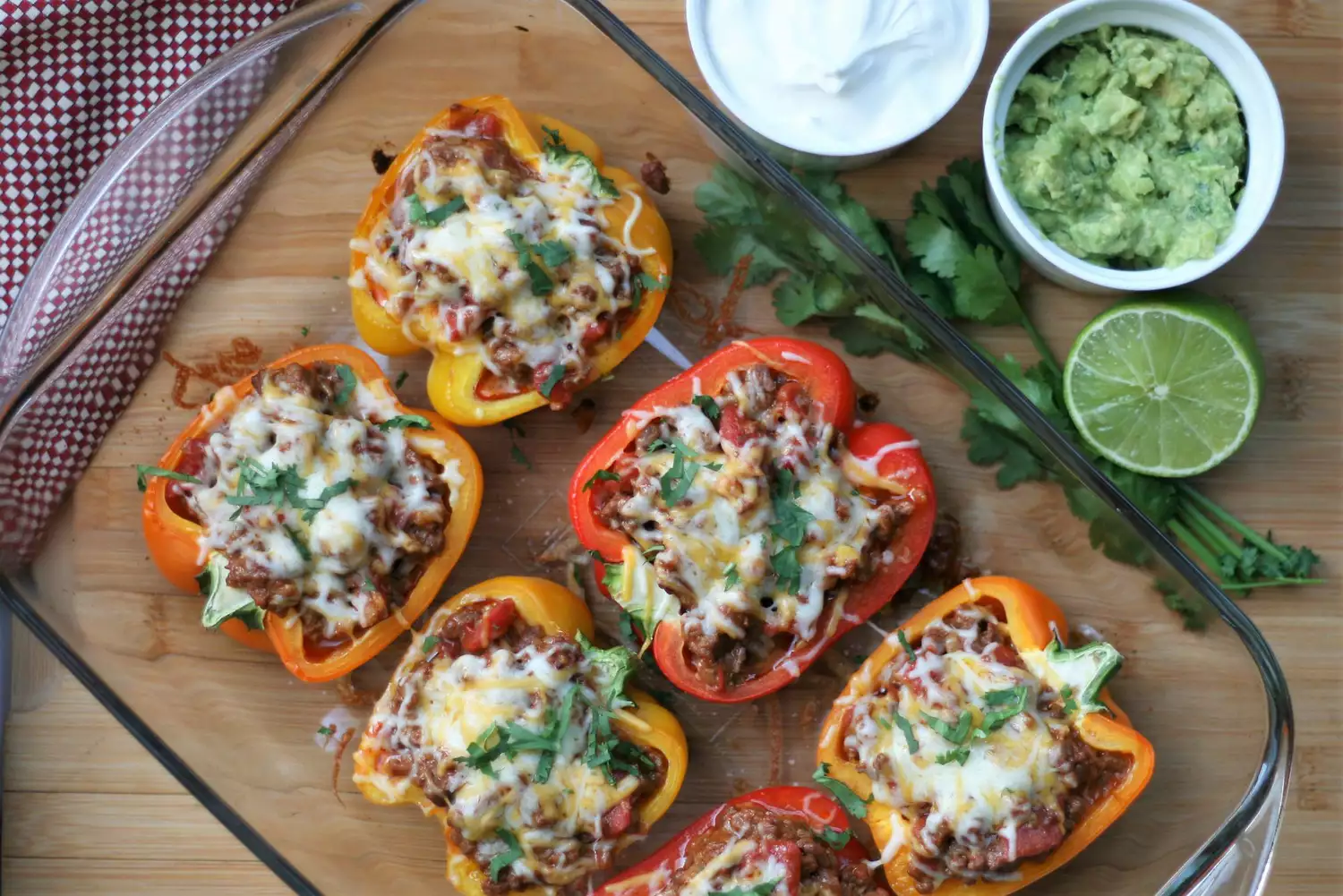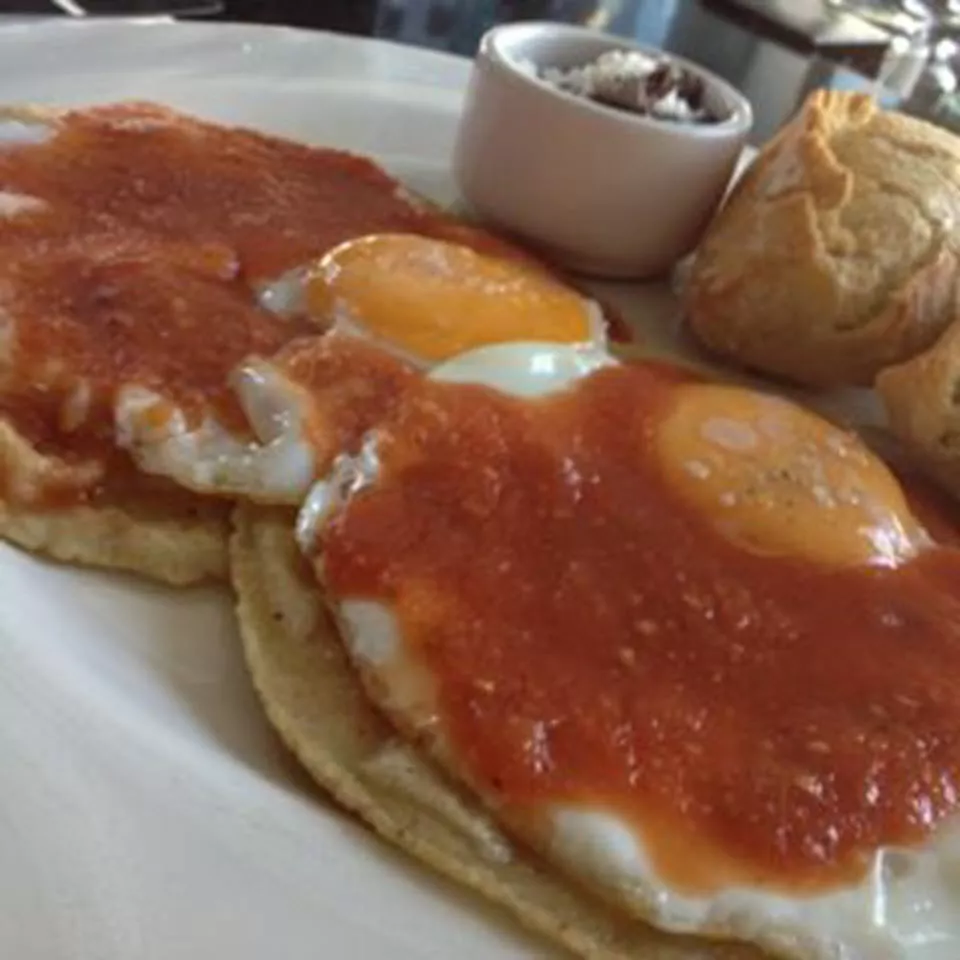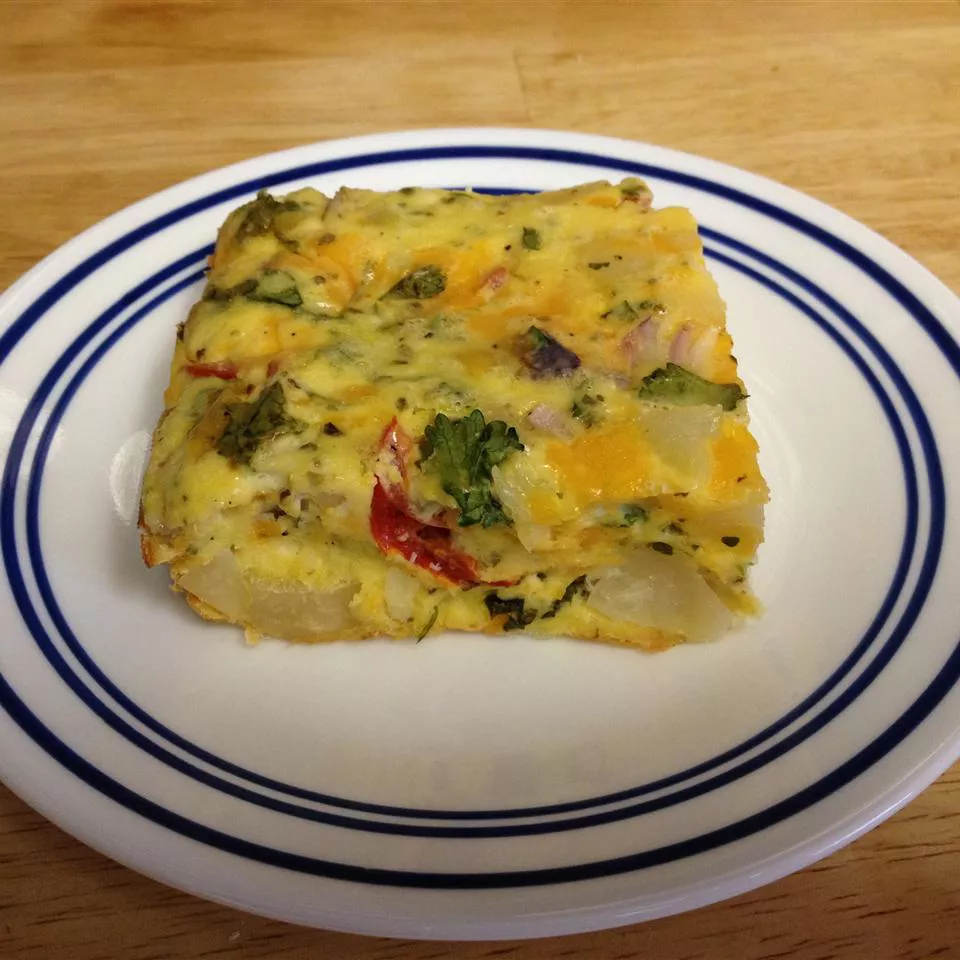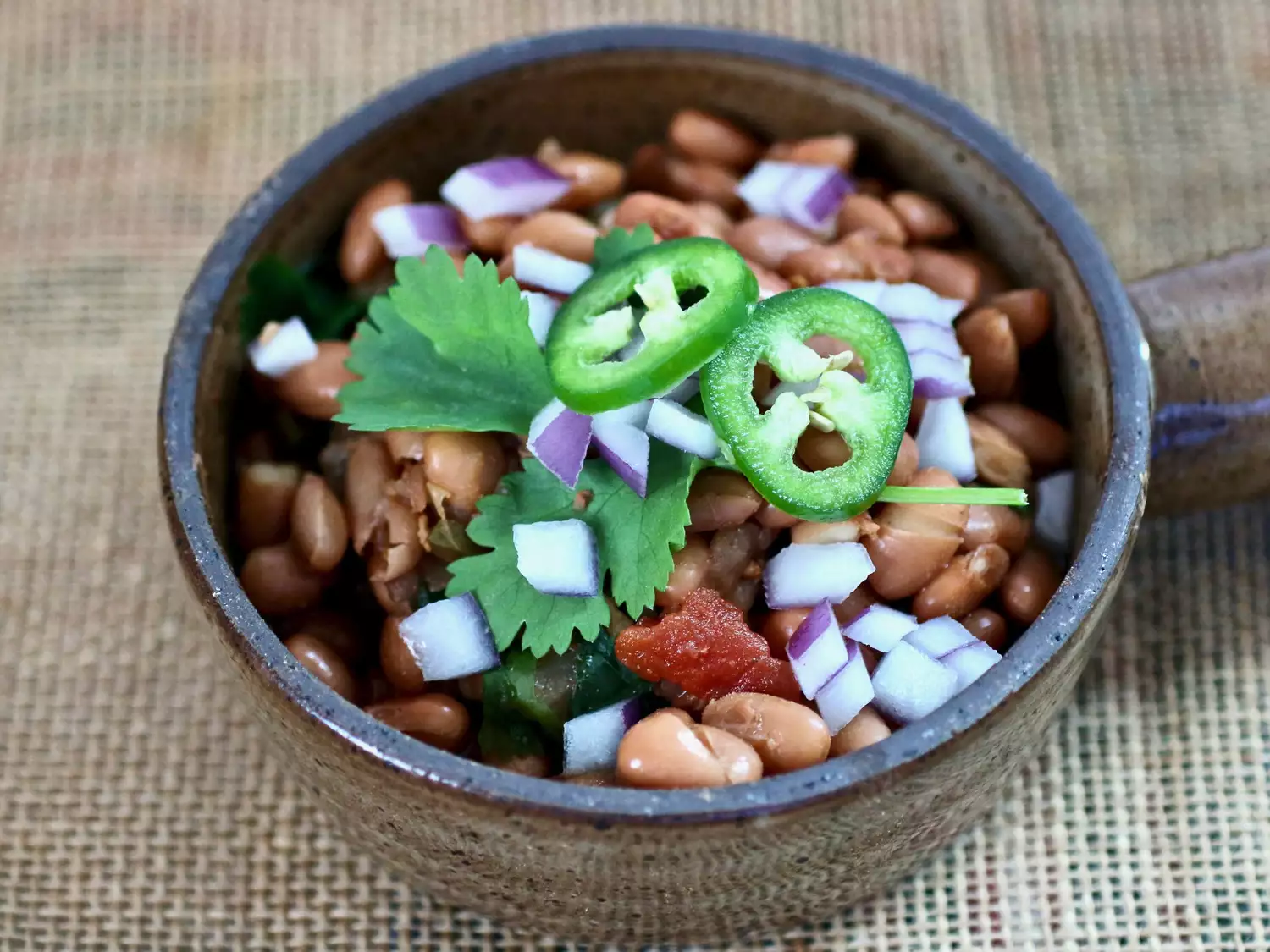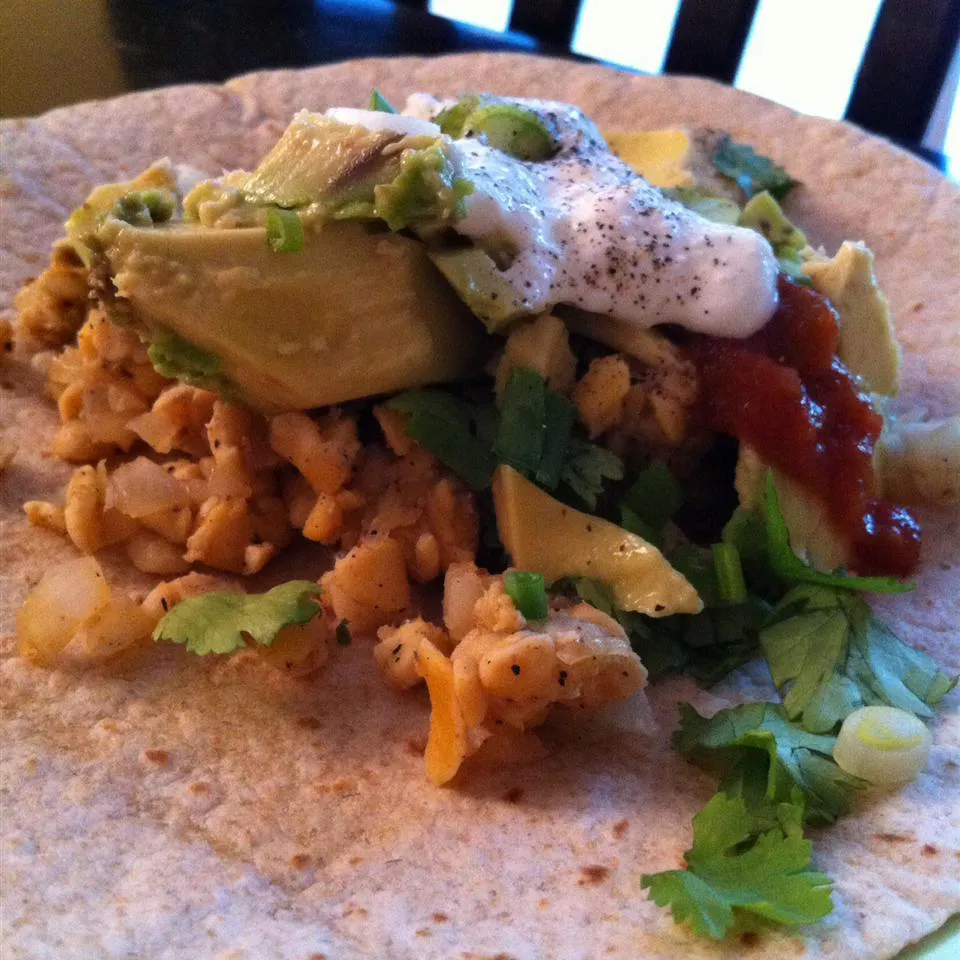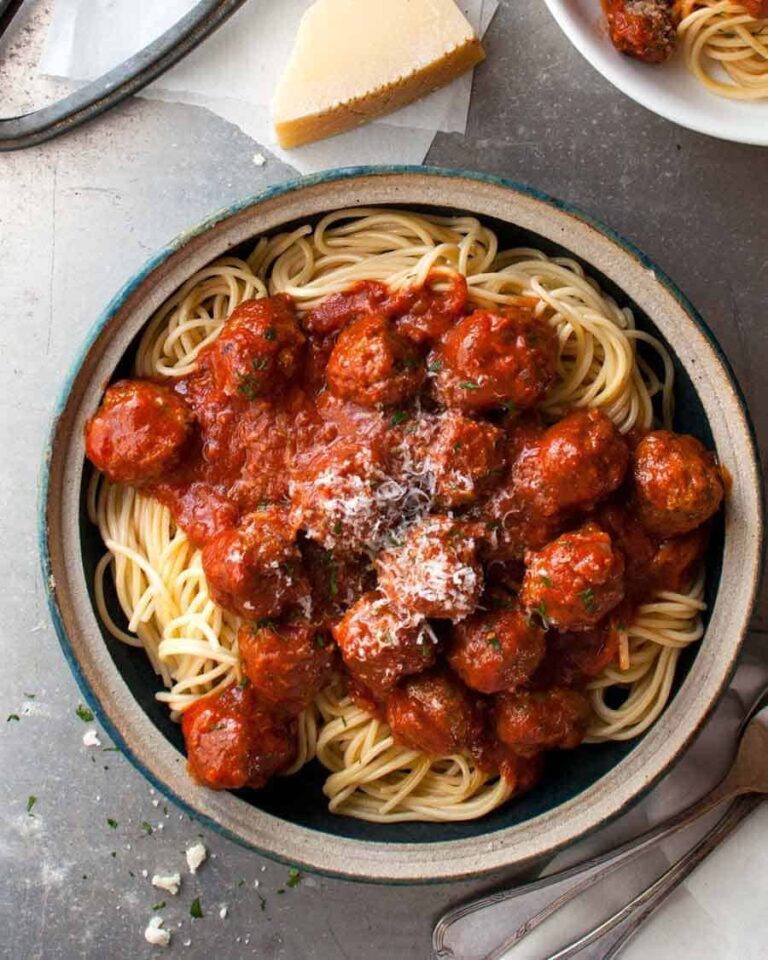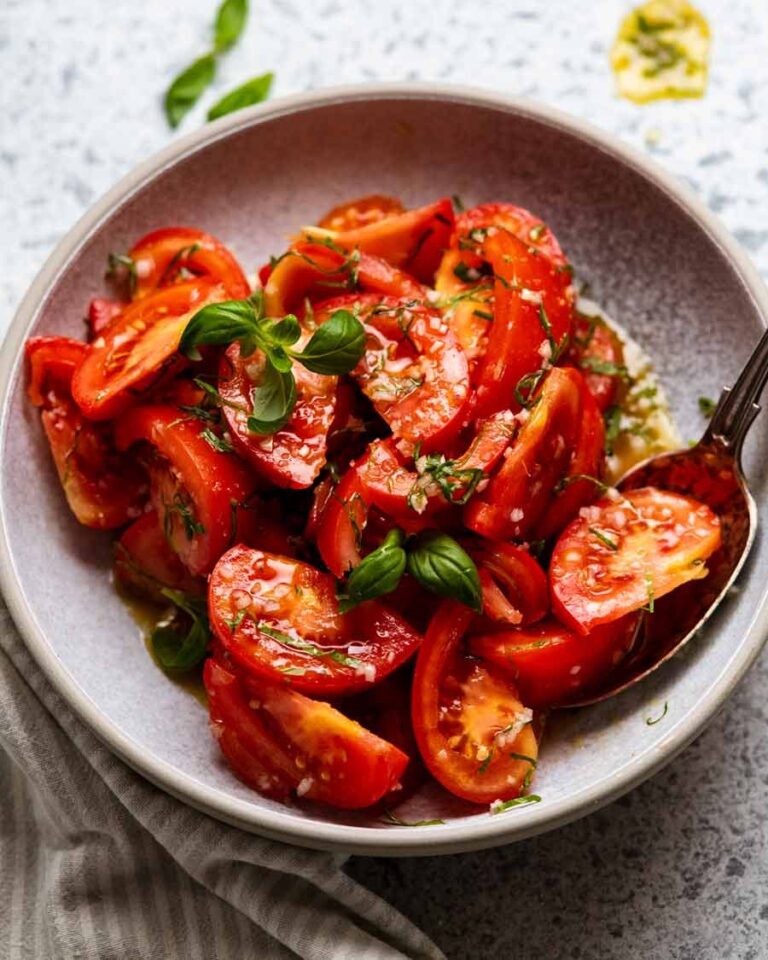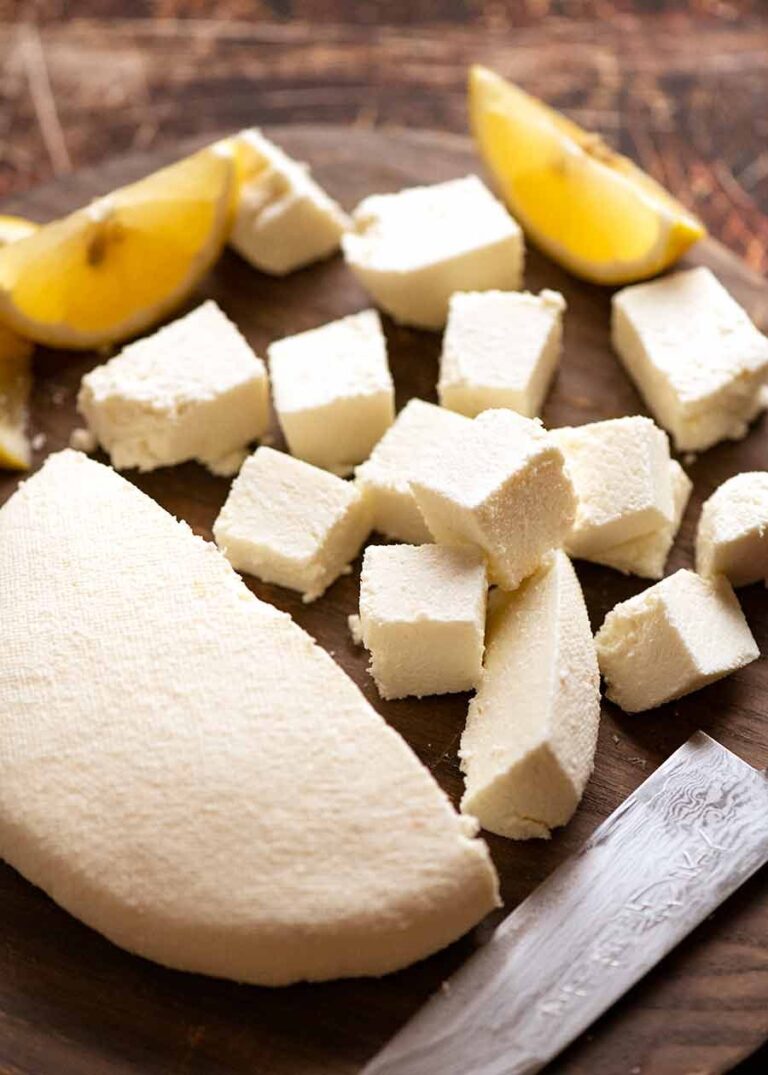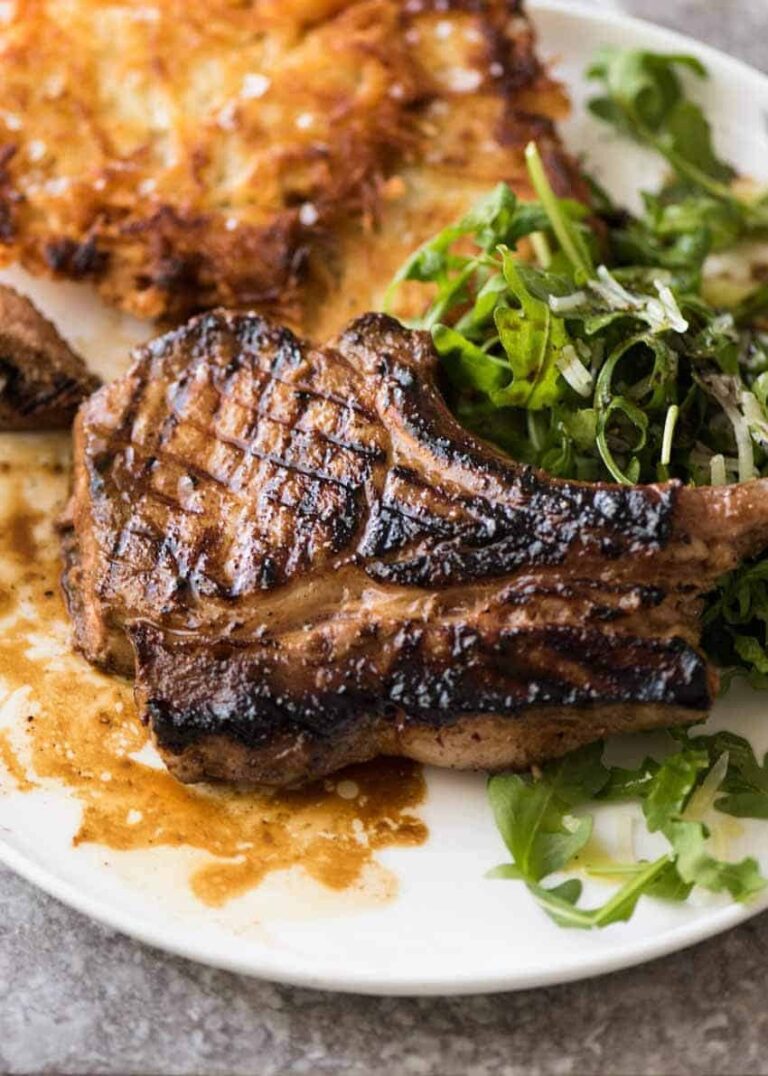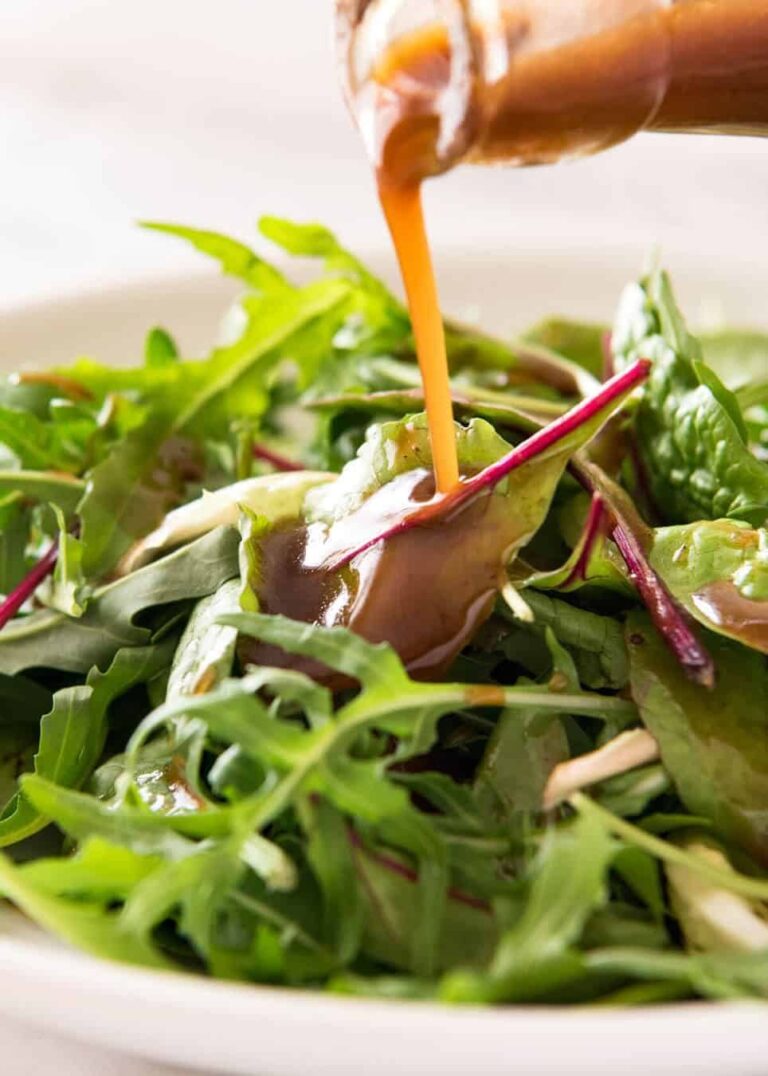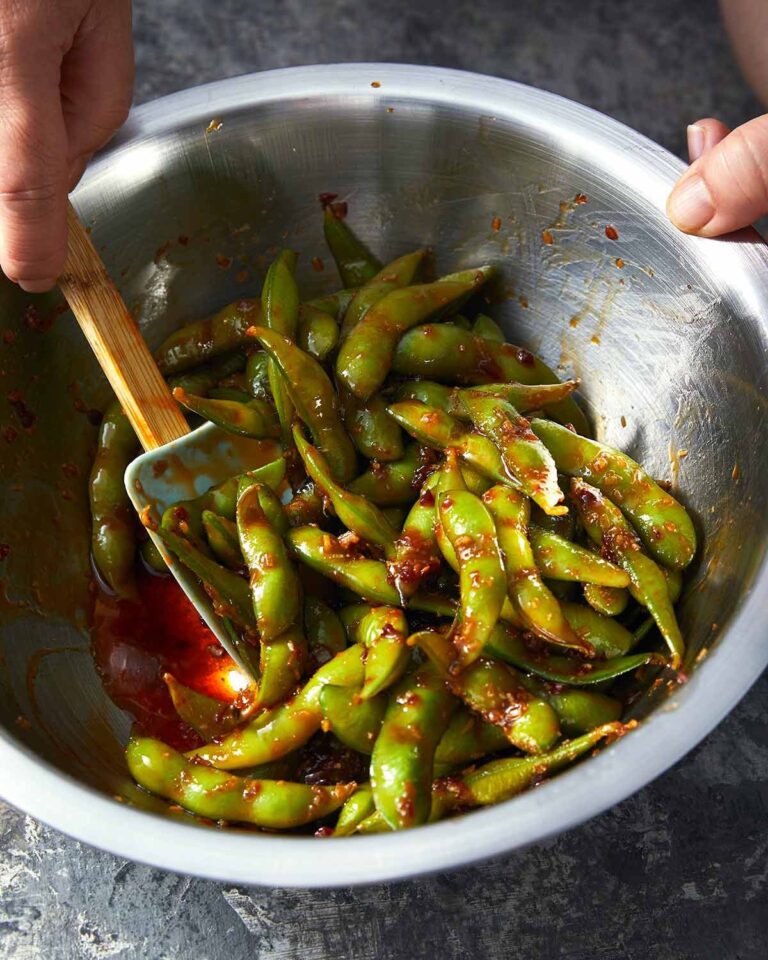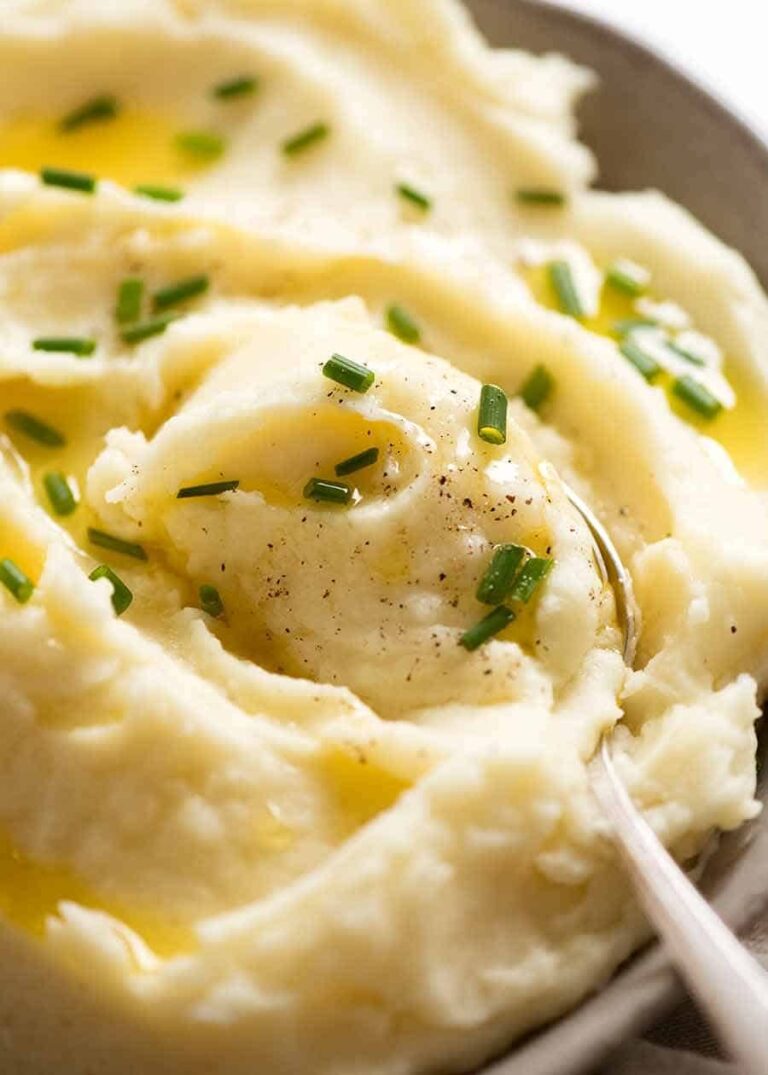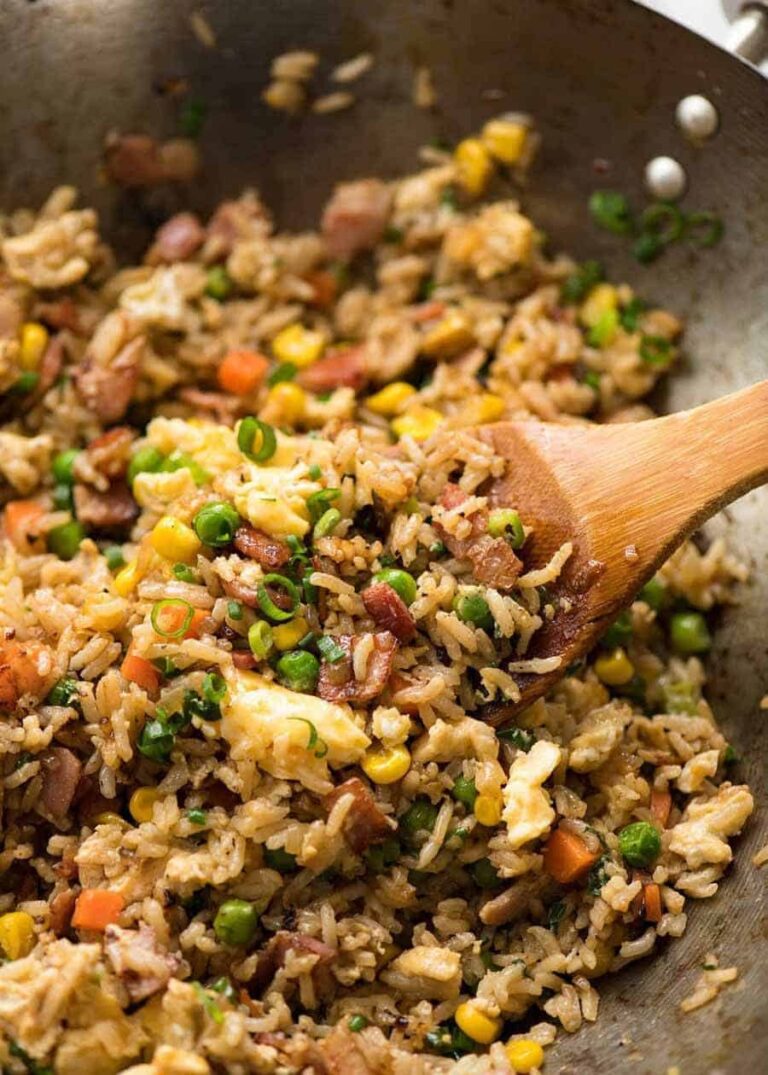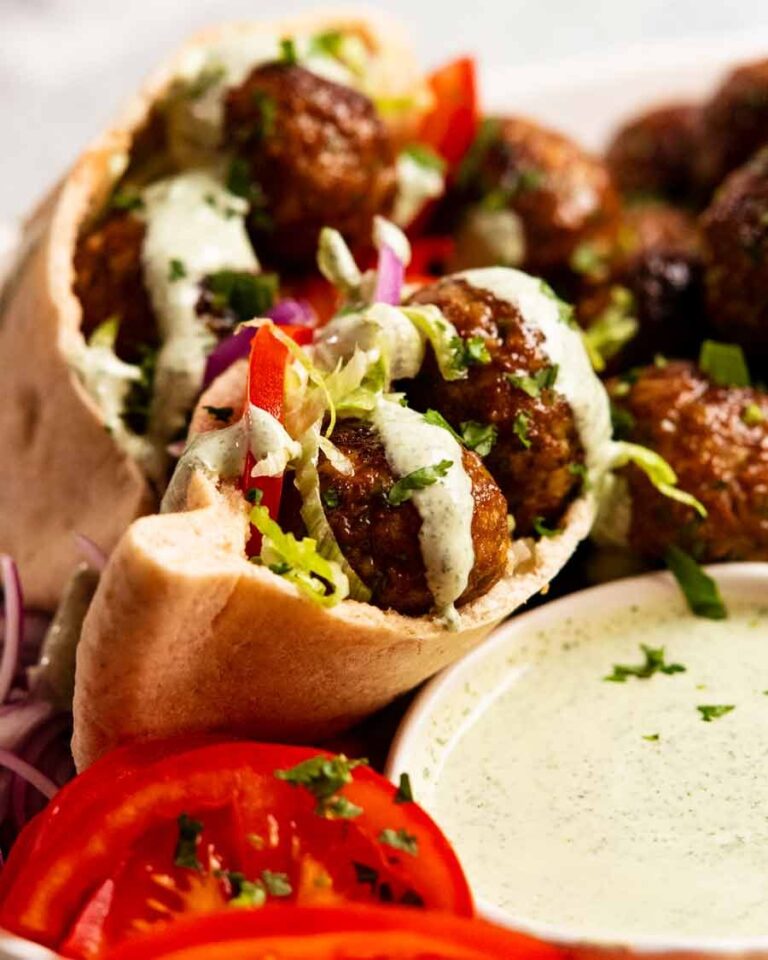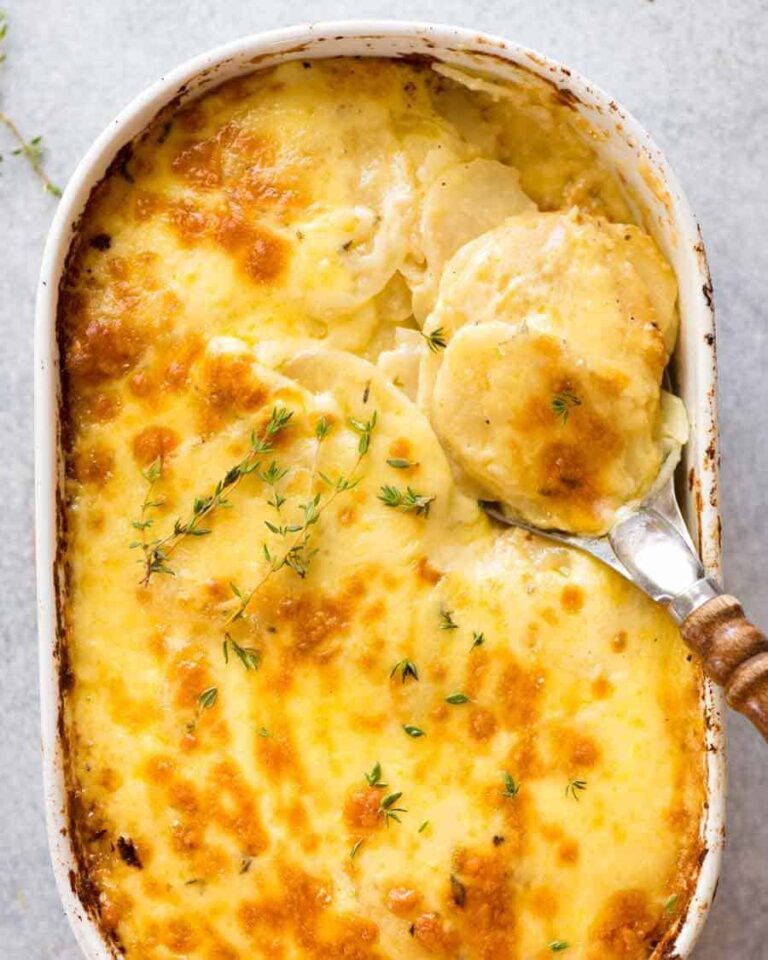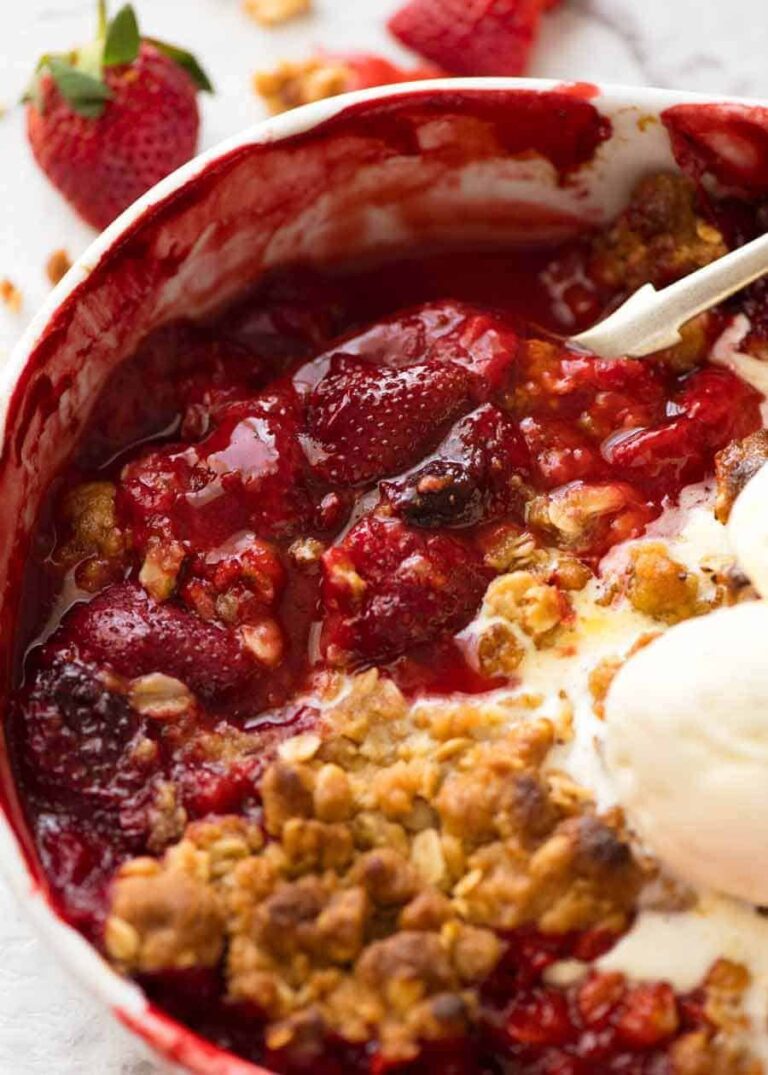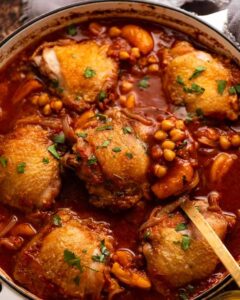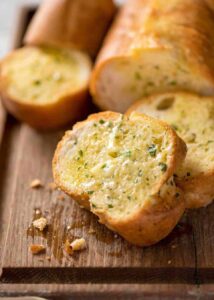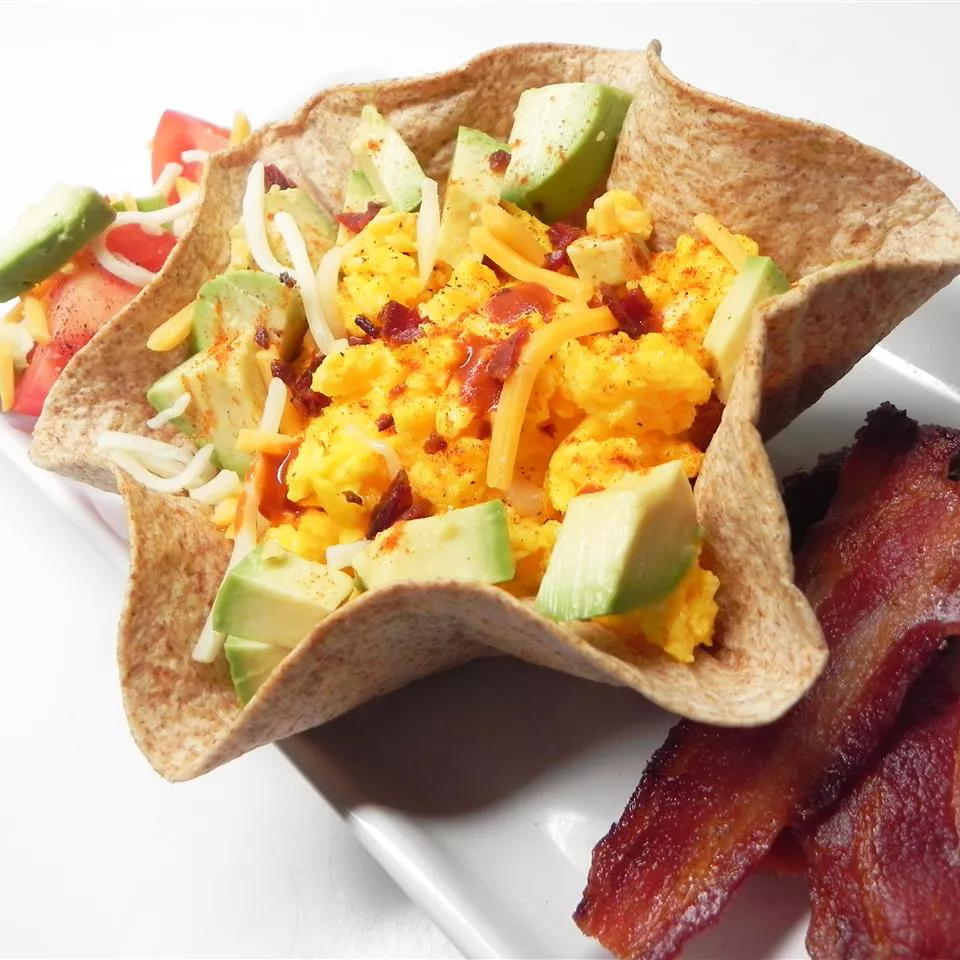
Thai Yellow Curry Recipe
Thai curries are well-known for the chic fragrant flavours balancing candy, tart, savoury and spiciness. Thai Yellow Curry is one such magnificent instance, with its wealthy yellow color and a heady mixture of herbs and spices on this made out of scratch Yellow Curry Paste.
And… welcome to Thai week!!
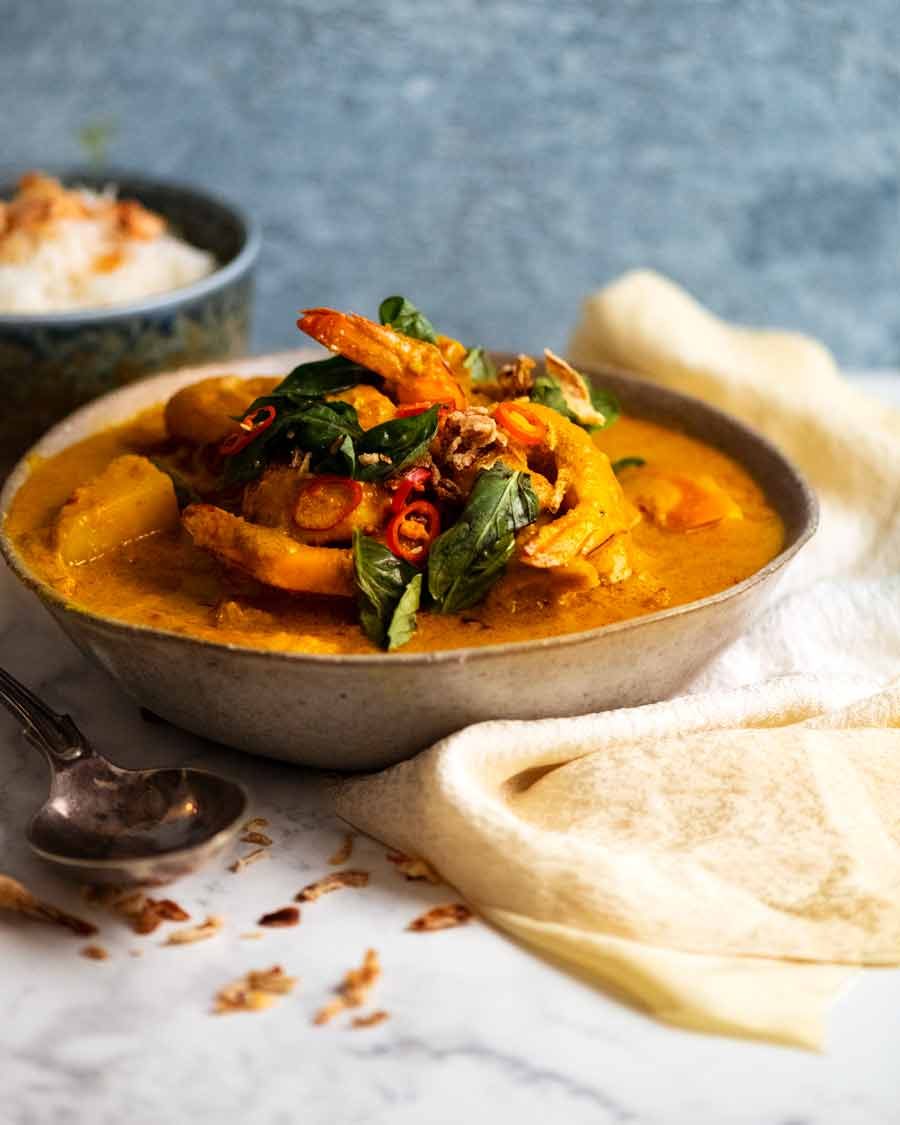
From time to time, I love to do a recipe theme week. This week it’s THAI week, with three basic recipes to make your very personal Thai feast at house:
-
Thai Yellow Curry (in the present day’s recipe) – Comprised of scratch, that is flavour you actually can’t purchase in a jar!
-
Inexperienced Papaya Salad
(coming Wednesday)– Nice as aspect, but substantial sufficient as a starter. -
Thai Black Sticky Rice Pudding for dessert! It’s arduous to consider you can also make one thing so scrumptious that’s essentially, made with simply rice, water and sugar…

There are numerous issues to like about Thai meals, however for me, the jewel within the crown are the curries. I like that elusive mixture of contemporary fragrant herbs and spices with the complexity you get from utilizing umami loaded seasonings similar to fish sauce and shrimp paste. The colors, in the meantime, make up a rainbow of deliciousness! Hanging Thai Purple Curry, vibrant Inexperienced Curry, caramel colored Massaman Curry.
And now, the most recent addition to my Thai recipe assortment – this lovely splash of sunshine within the type of Thai Yellow Curry!
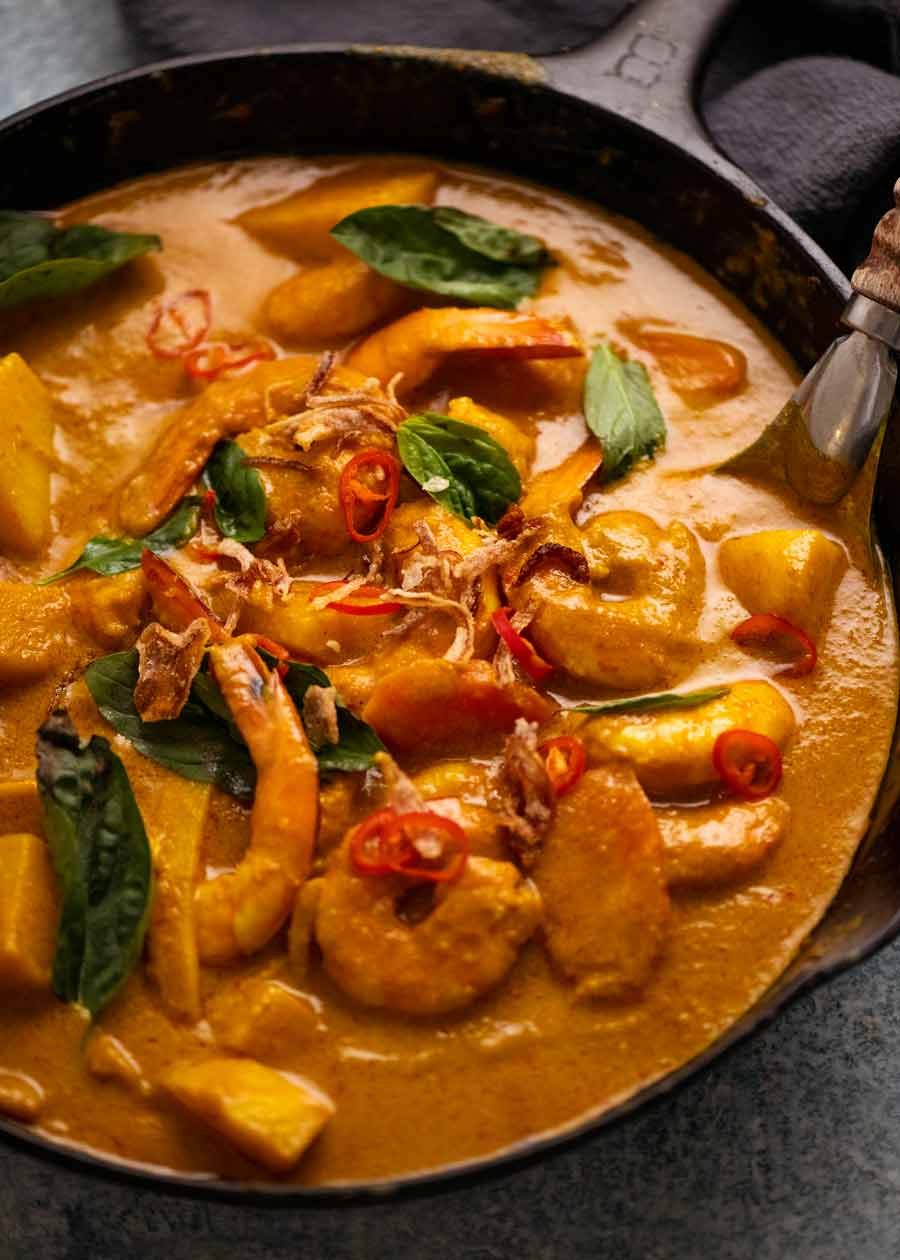
What’s Thai Yellow Curry?
There are a couple of sorts of what’s thought-about “yellow curry” in Thai delicacies. They range in spiciness and sauce richness, with some made with and others made with out coconut cream. The one factor all of them have in frequent is that the sauce is made with a good quantity of contemporary turmeric which provides the Yellow Curry that stunning heat golden color.
The Yellow Curry I’m sharing in the present day is the kind that’s commonest exterior of Thailand which has a reasonably wealthy sauce made with coconut cream. The spice stage varies from gentle (2 contemporary chillies) to fairly spicy (4 chillies).
What Thai Yellow Curry tastes like
The sauce is savoury, candy and aromatic with Thai aromatics together with lemongrass, turmeric, garlic, eschalots and chilli. It may be as gentle as you need or fairly spicy – I get pleasure from it each methods.
It’s not as tangy as different Thai curries, with the compulsory squirt of contemporary lime juice you see in different Thai curries noticeably absent on this one.
It’s acquired layers upon layers of flavours which suggests sure, there are fairly a couple of elements – and it’s value it! Not like different Thai curries, I actually don’t assume any retailer purchased curry paste comes wherever close to made out of scratch (sorry guys!).
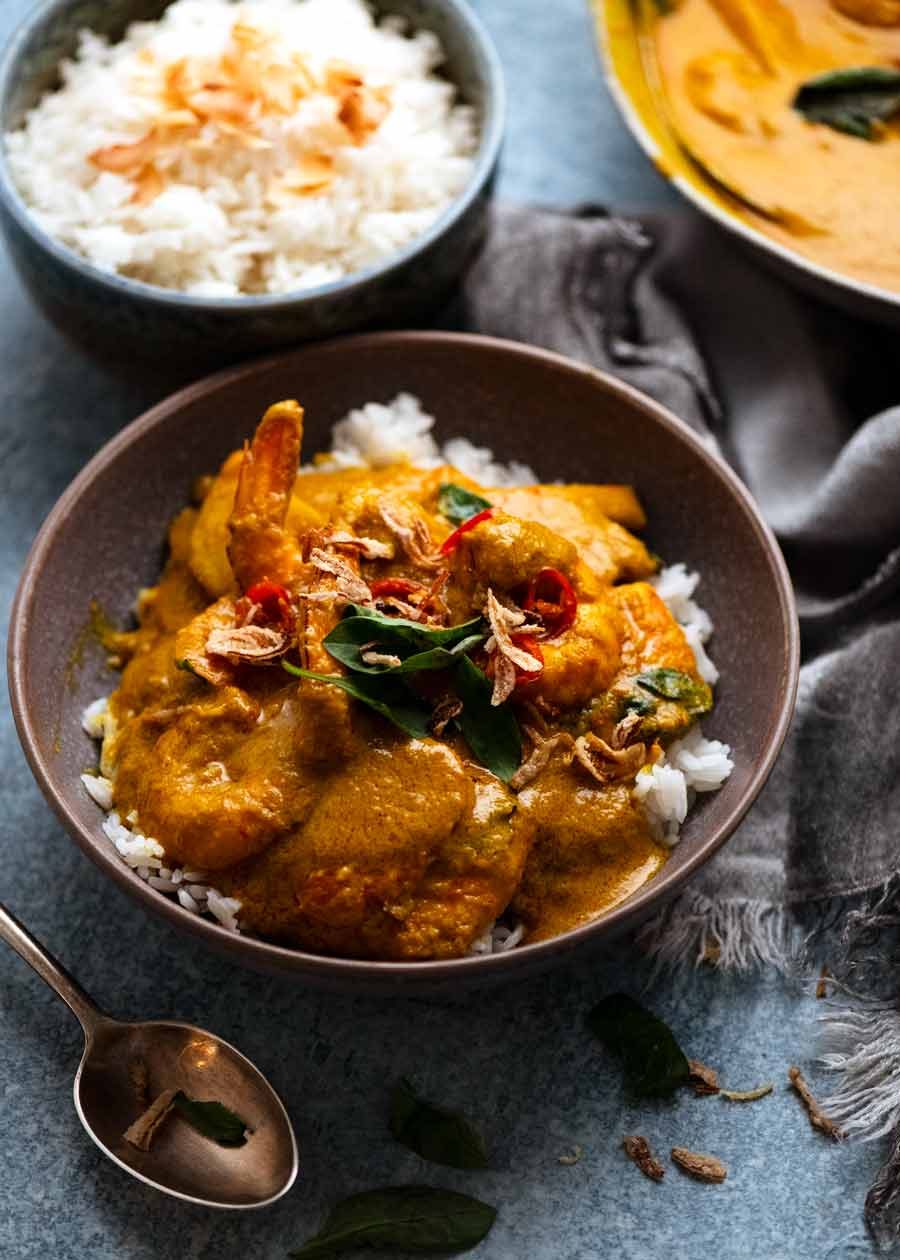
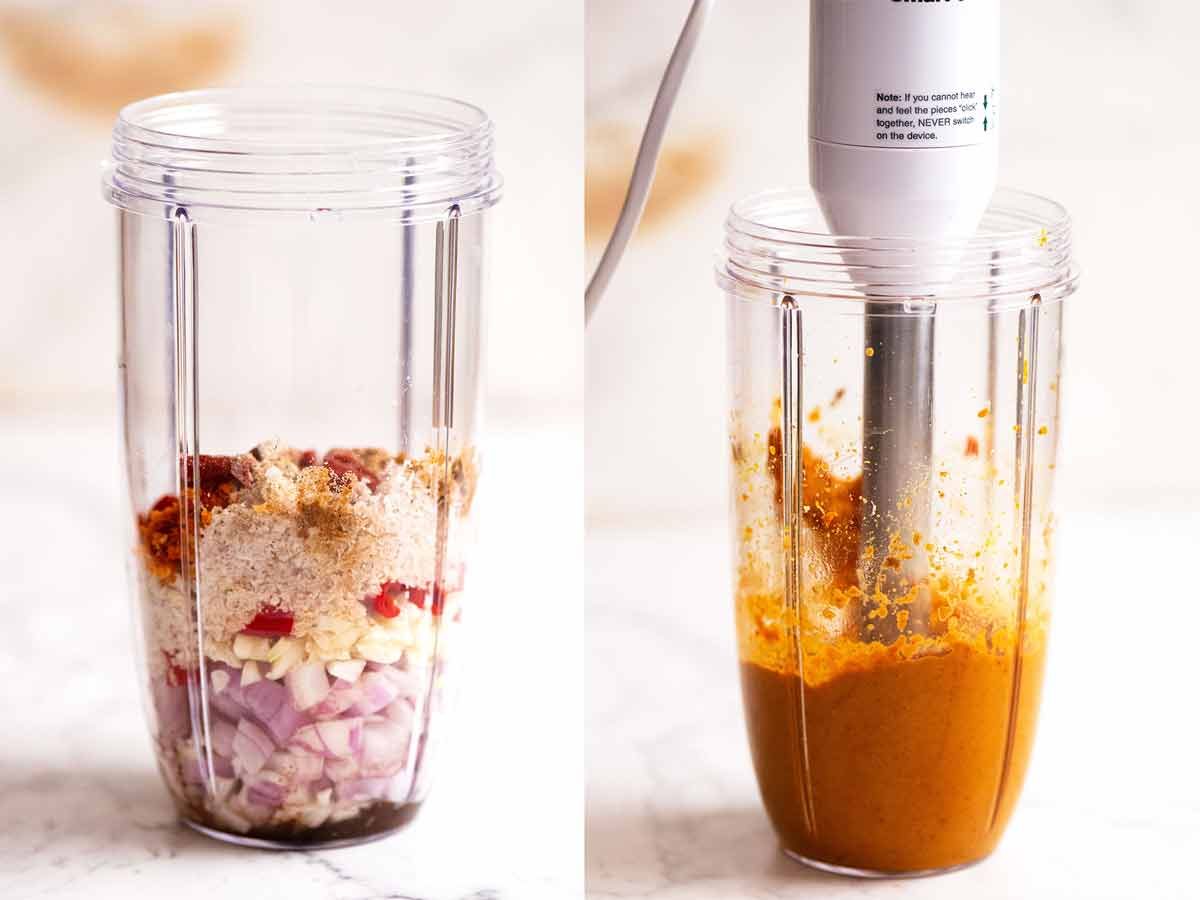
There are fairly a couple of elements concerned in making a yellow curry from scratch if you would like a very genuine consequence. I urge you to attempt making this at the very least as soon as – the style is incomparable to canned pastes! And actually, I actually can’t advocate any retailer purchased yellow curry paste.
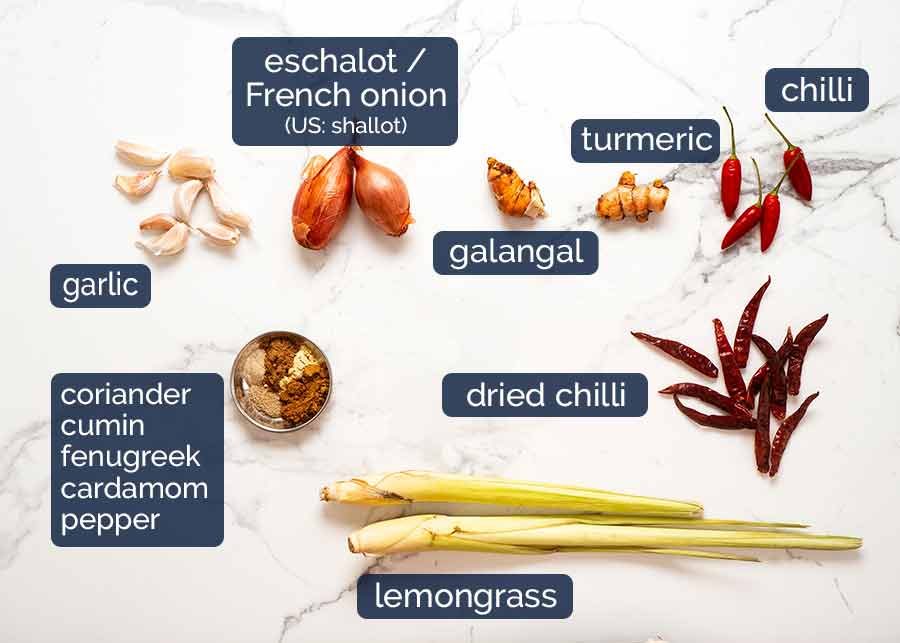
Dried purple chillis
Dried purple chillis have a rounded flavour in comparison with contemporary chillies and have a mellower warmth. That mentioned, it’s a good suggestion to style the chillies to gauge the spiceiness and regulate accordingly. (Finest to nibble as soon as soaked)
In the event you don’t have dried chilli you should utilize extra contemporary chillis as a substitute.
Right here is how we put together the dried chillis:
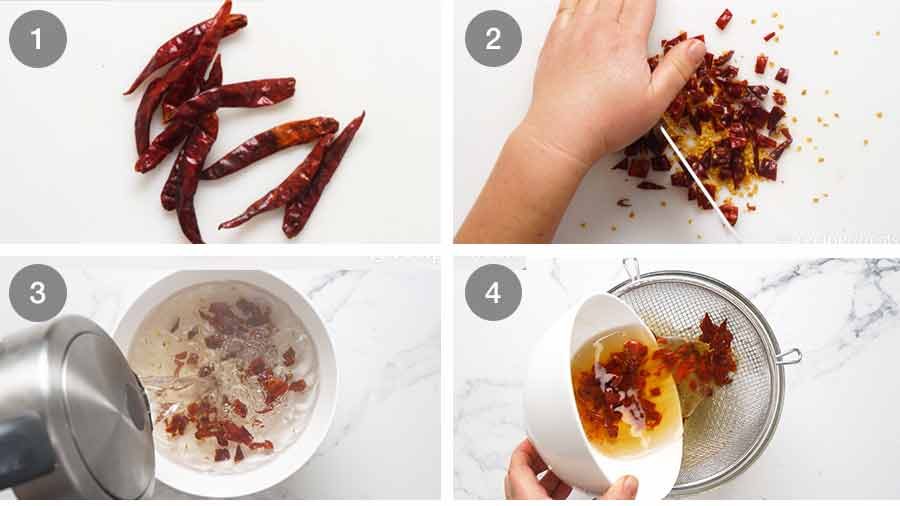
-
The dried chillis come entire with seeds inside them.
-
Roughly chop – this makes it simpler to rehydrate, blitz right into a paste, and likewise this loosens the seeds that are spicy. Decide up the chillis solely, abandoning the seeds, and put them in a bowl.
-
Cowl with boiling water and depart for half-hour to rehydrate.
-
Pressure chillis and reserve the soaking liquid – we’re going to use a few of it for the curry paste.
Contemporary birds eye chillis or Thai chillis
These deliver a vivid and contemporary style of chilli against this, in addition to the actual kick!
1 or 2 chillies will give this curry a light to medium stage warmth. Use 4 chillis for pretty spicy however not blow-your-head-off. In the event you’re involved, you may depart them out!
Right here is how I deseed and chop contemporary chillies. Sure, I do know I ought to use gloves. I neglect! (Normally adopted by a watch rub with chilli fingers, copious quantities of swearing, and vowing by no means to make the error once more. Repeat.)
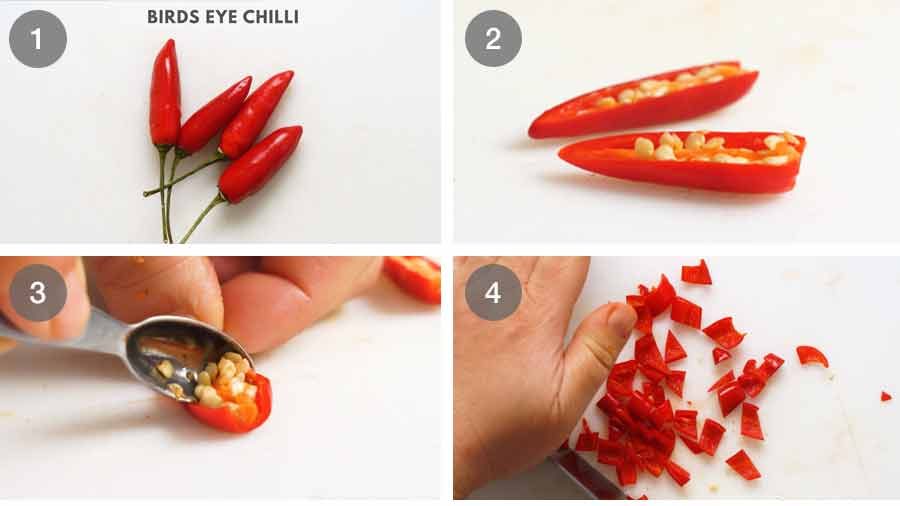
TIP: A measuring teaspoon makes a great instrument for scraping out the seeds (these are the spiciest a part of chillies). Sharper edges than consuming teaspoons, and the form is ideal for seed scooping.
Lemongrass
Aromatic, with a delicate citrus style, lemongrass is a quintessential South-East Asian flavour. To organize, reduce and discard the highest reedy half off – we solely need the underside 10 – 12cm / 4 – 5″. Peel the reedy inexperienced shell to disclose the softer white half on the underside half of the lemongrass.
Substitute: 2 tablespoons of lemongrass paste.
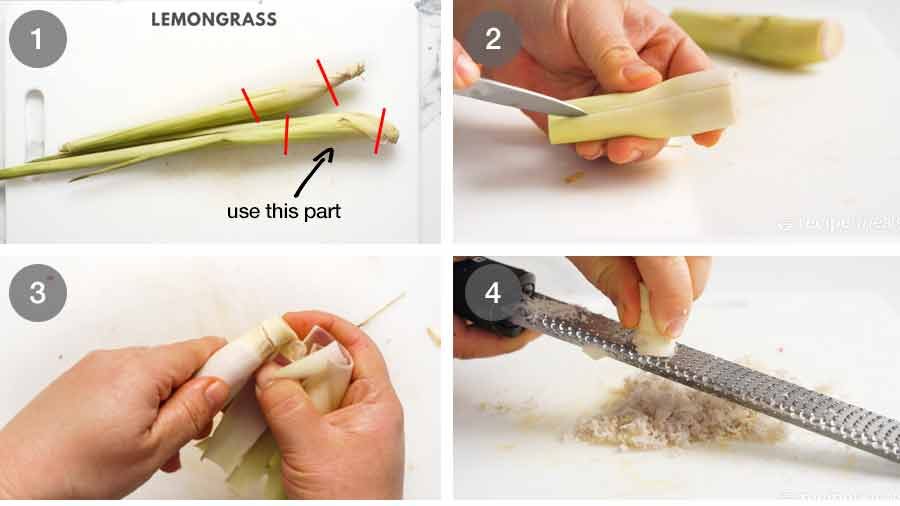
Galangal
This can be a plant root utilized in South-East Asian cooking that appears just like ginger. It additionally tastes like ginger however is extra citrusy and a bit pine-y. It’s really fairly arduous to chop so take care when slicing it! Peel it like ginger, both with a pointy edge teaspoon or (fastidiously!) with a small knife.
This must be finely grated as a result of it’s so arduous, it doesn’t mix right into a clean paste, you find yourself with little gritty bits. I take advantage of my microplane, one among my favorite kitchen instruments – extra info right here.

Discover galangal at Asian shops, and in some massive grocery shops in Australia (Harris Farm and a few Woolworths promote it).
Substitute: Use the identical quantity of ginger + the zest of 1 lime (or lemon).
Contemporary turmeric
Turmeric is what offers this curry its important golden color, and there’s no yellow curry with out it! Contemporary turmeric is a root that appears a bit like ginger on the surface however is vivid orange on the within.
The flavour is gentle, earthy and barely bitter eaten by itself. Its major use in cooking is for healthfulness and for color.
Put together it like ginger – peel the pores and skin (scrape utilizing teaspoon or reduce off with a small knife), then grate.
Turmeric stains fiercely as soon as grated! Use gloves when dealing with it, and grate it onto a ceramic or steel plate or bowl. (And sure, the observant amongst you’ll discover that but once more, I failed on the gloves entrance till I began grating it!).
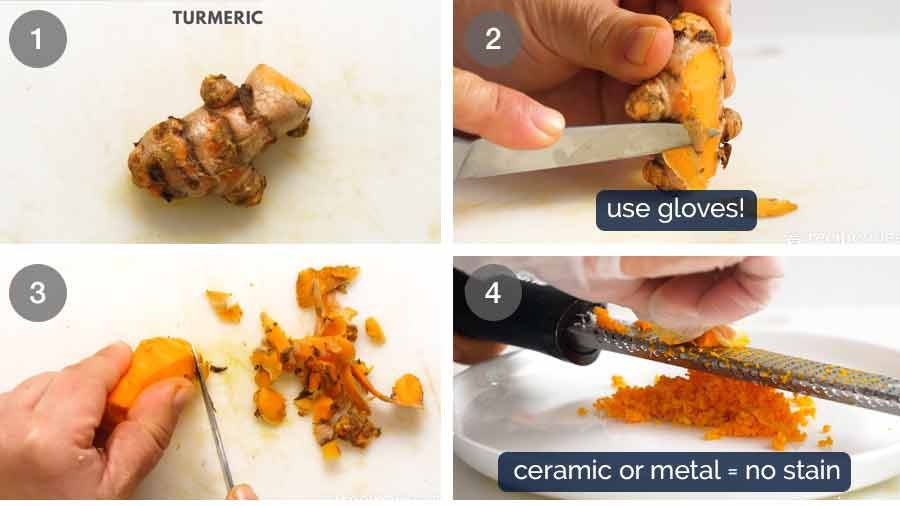
Substitute: 1.5 tsp dried turmeric powder, but it surely gained’t be fairly the identical so I actually urge you to make use of contemporary for those who can!
Shrimp paste in bean oil
I take advantage of Por Kwan Shrimp Paste in Bean Oil, the preferred Thai shrimp paste bought at Asian grocery shops right here in Australia. Whereas many conventional recipes use extraordinary shrimp (belacan, in blocks, appears to be like like this) which is made with simply fermented shrimp, Shrimp Paste bought in jars the place different flavouring have been added (primarily oil, a little bit of garlic, and soy sauce powder) goes a protracted approach to making a very restaurant high quality curry paste.
That is particularly so when utilizing a blender as a substitute of mortar and pestle as when dried chillies are floor by hand the normal, the pure oils are extracted. So utilizing a shrimp paste in oil makes up for this.
Por Kwan is the model I take advantage of, pictured under, which is bought at Asian shops.
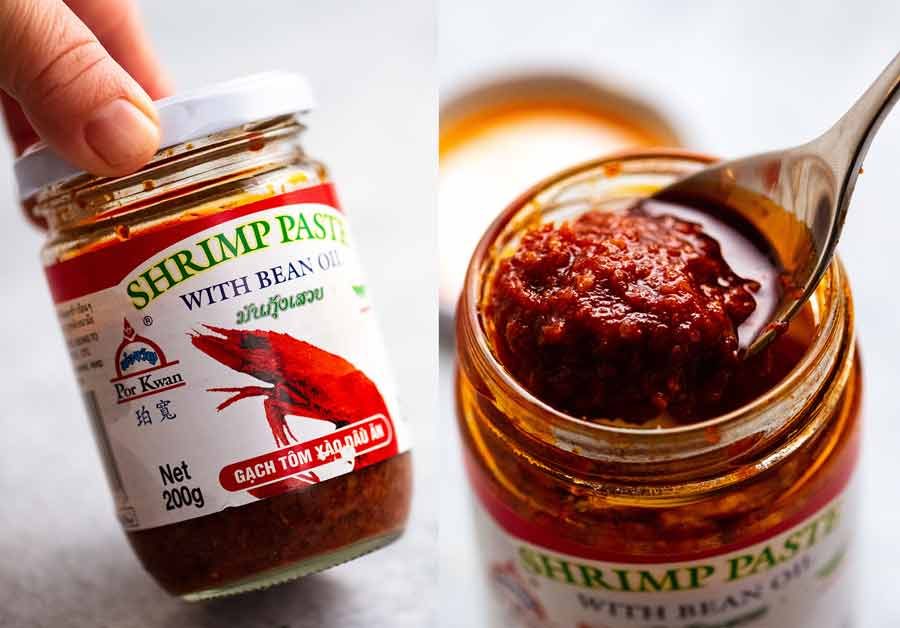
Finest alternate options to Thai Shrimp Paste with Bean Oil:
-
Belacan dried shrimp paste which is even bought at Woolworths and Coles in Australia today. The consequence could be very near utilizing Thai Shrimp Paste with Bean Oil!
-
Different Thai Shrimp Pastes in Oil – Solely Thai shrimp pastes. We tried another shrimp paste manufacturers bought at Woolworths (made in Vietnam and Cambodia) and whereas nonetheless tasty, they introduced a distinct flavour to the dish.
In the event you don’t have entry to Thai shrimp paste or belacan, I’m afraid I’d counsel giving this recipe a miss as a result of I can’t assure the result might be profitable!
Different elements
-
Garlic – Sure, 8 cloves! It seems like quite a bit however the paste might be fried off and the curry simmered for a great 15 – 20 minutes. The garlic will in no way be apparent within the remaining dish however mellows to grow to be simply one other instrument taking part in on this flavour orchestra.
-
Spices – Coriander, curmin, cardamom, fenugreek powder and white pepper. Our spice choice for this yellow curry which displays the Indian affect on Yellow Curry. Massaman Curry is one other such instance of a Thai Curry with Subcontinental influences.
We go a bit heavier on the spices for yellow curry in comparison with purple or inexperienced curries, that are pushed extra by their heavy chilli content material than spices. Of those spices, fenugreek is perhaps the toughest to seek out. In the event you would not have it, depart it out.
When you’ve ready the elements, it’s so simple as blitzing!
TIP: Use a stick blender. Far more efficient than blenders, Nutribullets and mini meals processors which you want to scrape down repeatedly to blitz totally. To not point out simpler to wash!
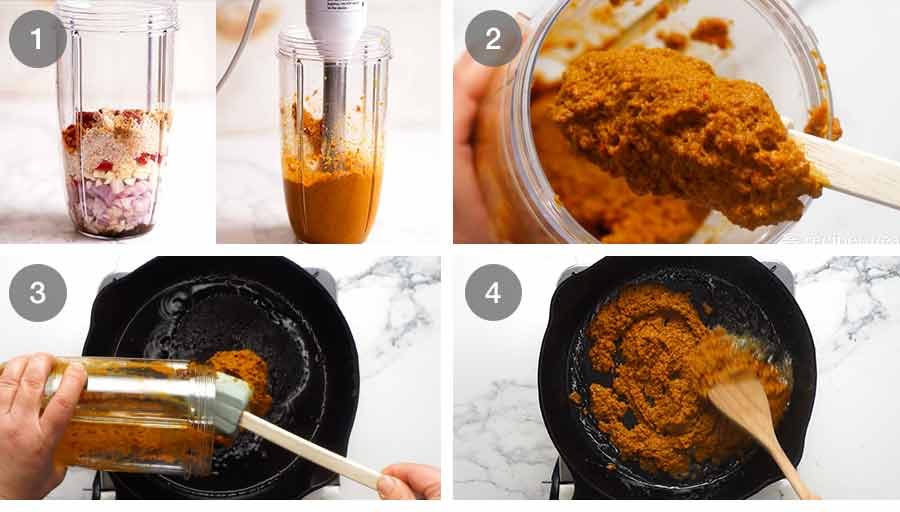
After we’ve made the curry paste, we cook dinner it on the range for a couple of minutes on a medium warmth. The aim of this step is to dry out the moist paste, toasting the herbs and spices to accentuate the flavour.
Yellow curry paste finished – now it’s onto the curry. You’ll be glad to listen to it’s a easy plonk-and-simmer job!
For this curry, I selected prawns (shrimp) as a result of seafood is a well-liked selection in yellow curries. Chicken and fish are additionally different favourites for yellow curry which you should utilize as a substitute. I’ve included instructions for each these within the recipe notes.
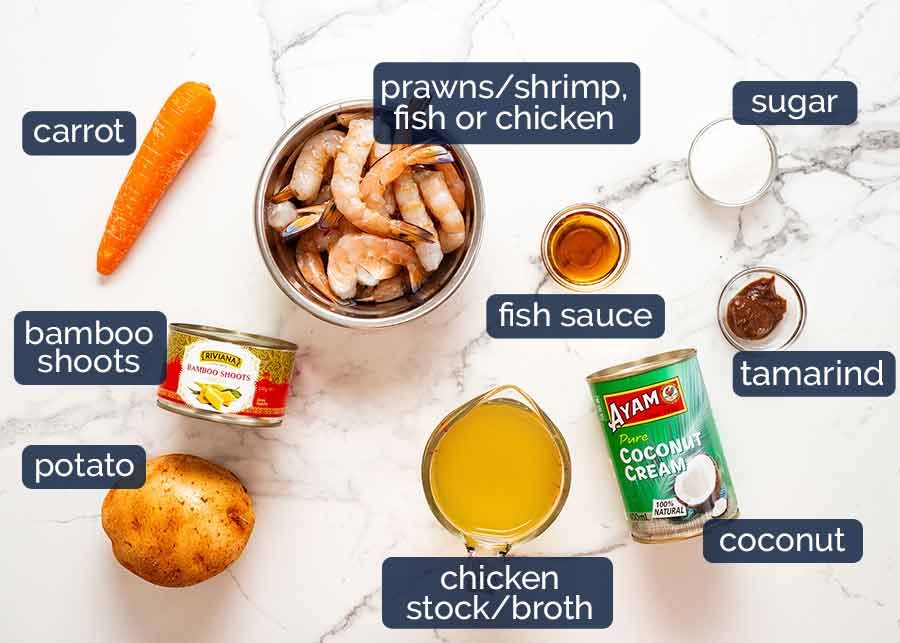
-
Prawns (shrimp) – I like to make use of medium prawns as small prawns fast so shortly they don’t have time to soak up among the sauce flavour, and enormous ones are harder to serve / eat.
Use contemporary for those who can, and preserve the tail on. In any other case frozen thawed is completely nice. I don’t must let you know that the higher the standard of the prawn, the higher the dish!
Alternate options: Fish and chicken are standard alternate options to prawns, so I’ve included instructions for each of those within the recipe notes.
-
Potato – It’s essential to make sure you don’t reduce the potato too thick, or it’ll take a very long time to cook dinner as potatoes take a surprisingly very long time to cook dinner in coconut sauce! The chopping measurement is specified within the recipe.
Any sort of potato is OK (waxy or starchy) for this recipe, however waxy will have a tendency to carry its form higher.
-
Carrot – Ditto the carrots on the thickness caveat! Observe the recipe!
-
Coconut cream – We use cream to provide the curry sauce its thickness in addition to richness. You should utilize milk or lite variations, however the curry might be a bit thinner in consistency and fewer full in richness. Search for manufacturers which have a excessive proportion of coconut extract. Ayam model is my selection.
-
Tamarind puree – Tamarind is a bitter fruit pod whose pulp is utilized in South East Asian meals so as to add acidity to meals like this curry. You should buy it’s a jarred puree in massive Australian supermarkets (Coles, Woolworths) or Asian grocers.
-
Bamboo shoots – Bought in cans at massive grocery shops (Woolies, Coles, Harris), they’ve a crisp juicy texture and have a novel style. Substitute with inexperienced beans (for comparable form) or extra carrots.
This a part of the recipe actually is easy – simply simmer every part in a skillet.
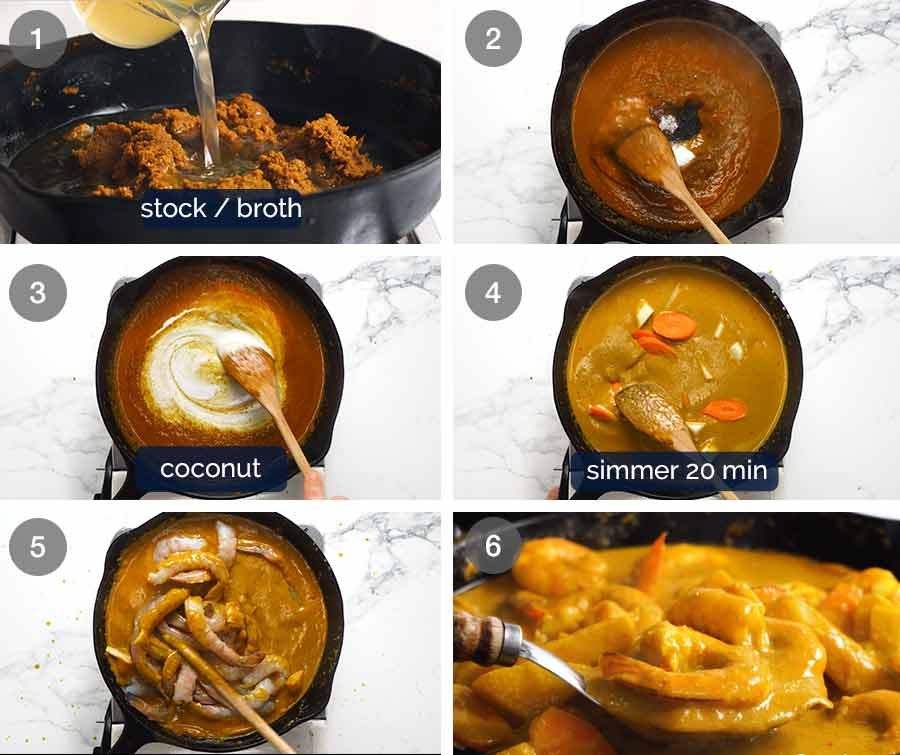
-
Add chicken inventory into the cooked off curry paste and stir to dissolve.
-
Simmer chicken inventory – Simmer on medium warmth for a minute to deliver the flavours collectively.
-
Add remaining curry sauce elements: Scale back warmth to medium low. Add tamarind, fish sauce and sugar. Stir till tamarind is dissolved.
-
Simmer 20 minutes – Add carrot and potato, then simmer the sauce for quarter-hour or till the potato is sort of cooked (pierce with a knife to examine), it’d take as much as 20 minutes. Potato takes a surprisingly very long time to cook dinner in a thick coconut curry sauce!
In case your warmth is just too sturdy and the sauce reduces and thickens too shortly, decrease warmth and add a splash of water.
-
Prawns and bamboo shoots: Add prawns and bamboo shoots. Stir, then cook dinner for 3 minutes till prawns are simply cooked.
-
Plate up! As soon as the prawns are cooked, take away the curry out of the recent skillet right into a serving bowl to forestall the prawns from overcooking. Overcooked, rubbery prawns in a do-it-yourself yellow curry from scratch is a miserable thought!
Subsequent, we’re going to complete the dish with a couple of garnishes!
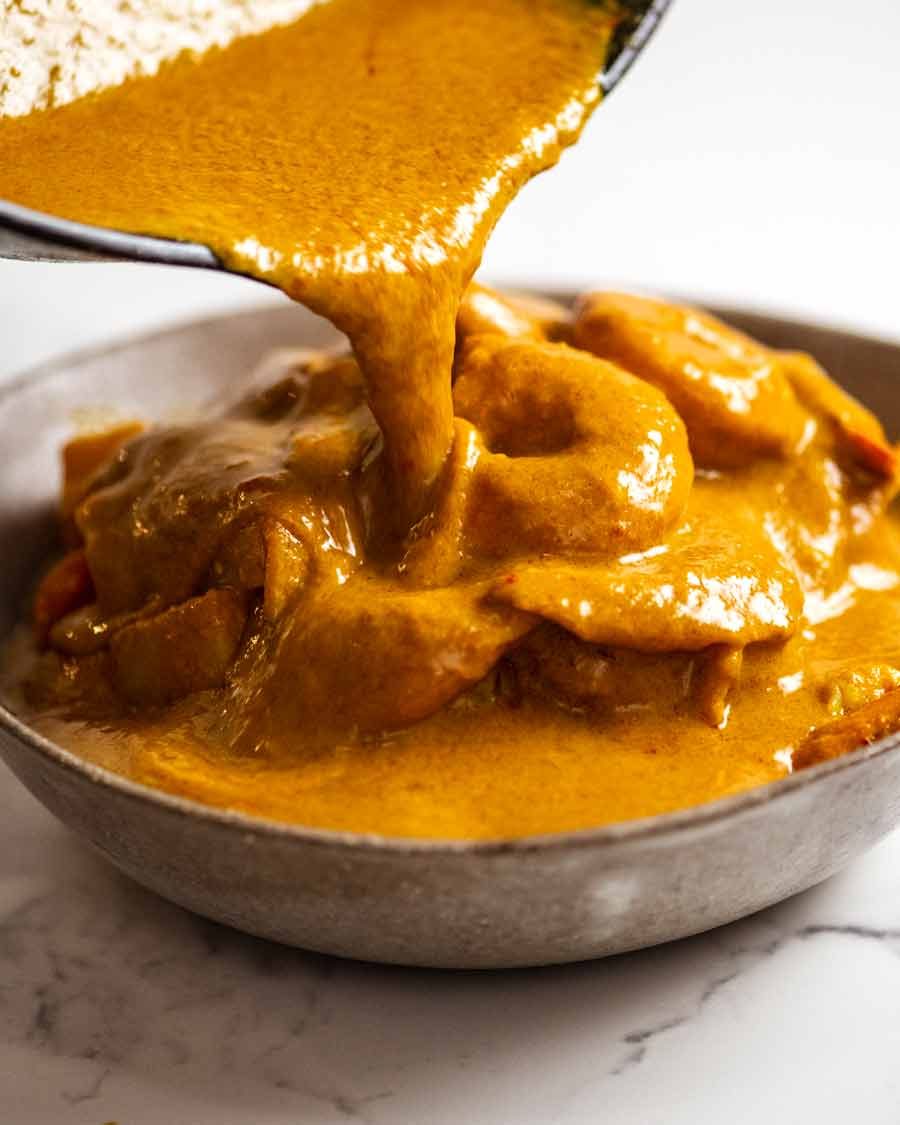
Listed below are the garnishes sometimes used to serve Thai Yellow Curry.
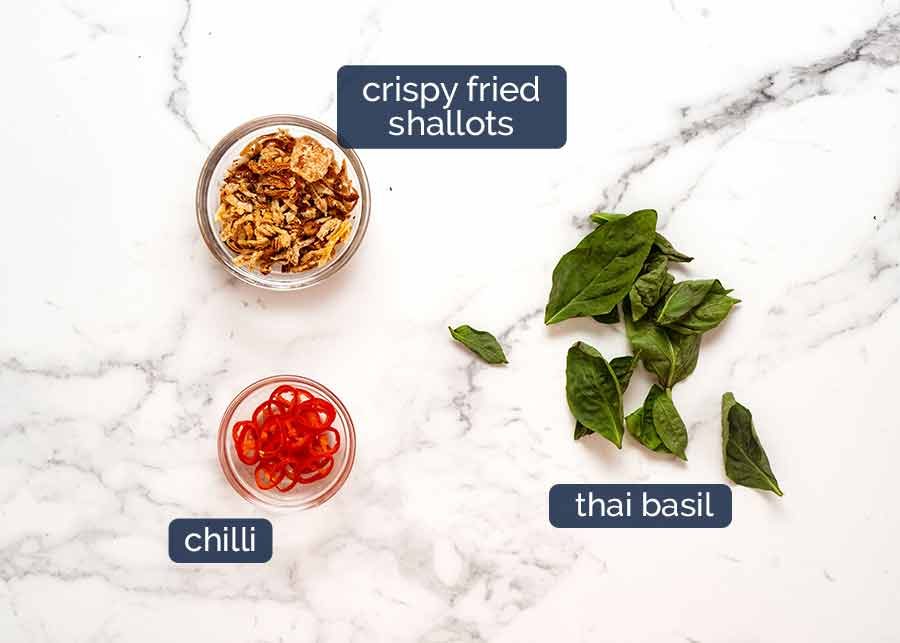
-
Thai Basil Leaves – Tastes like common basil plus a little bit of aniseed flavour. Extremely beneficial to complete this dish off.
Substitute with coriander/ cilantro (finest) or regular Italian basil.
-
Crispy fried shallot items (elective)– Salty little fried bits of shallots brings a terrific final touch to the dish each for the flavour and texture. Discover it within the Asian part of grocery store however cheaper at Asian shops.
-
Contemporary chilli slices – Purely possibility, for a splash of color and additional spice, if desired. Use massive chillies if you would like the color with out the spiciness.
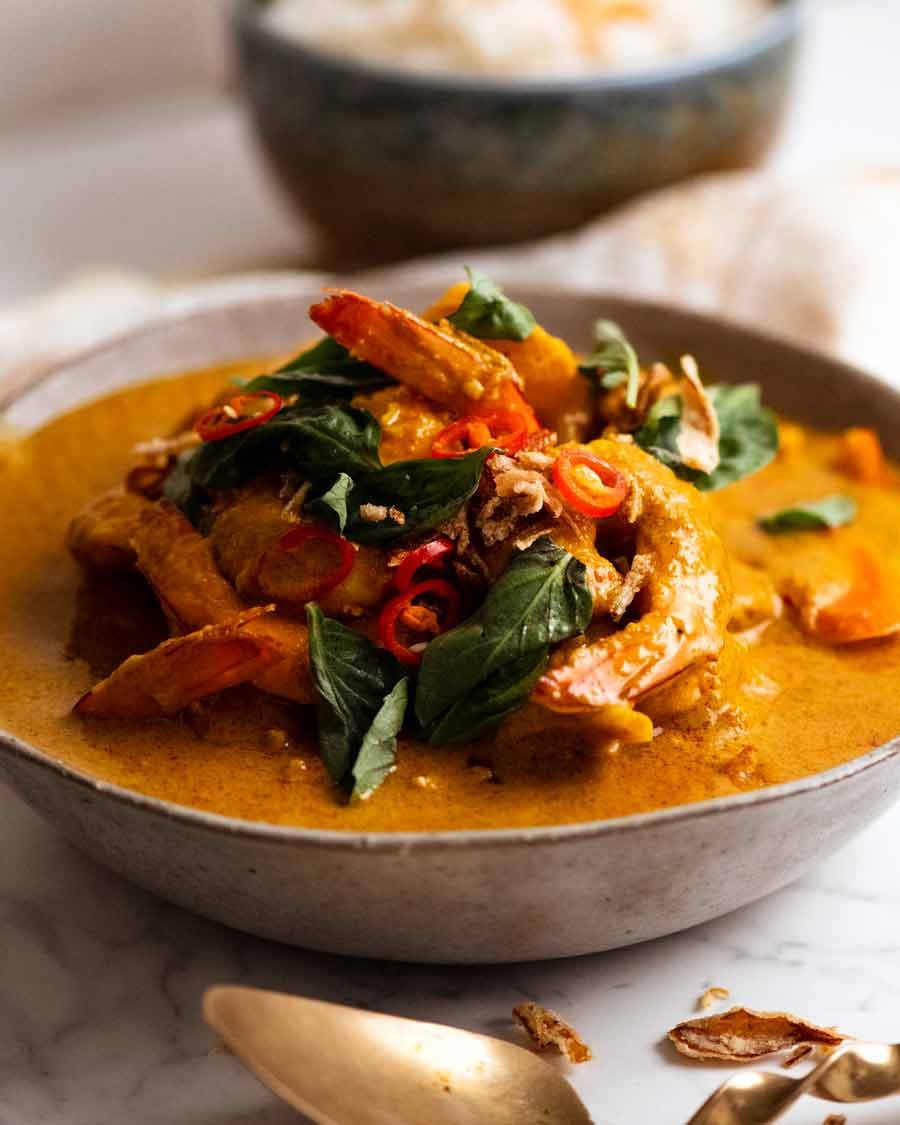
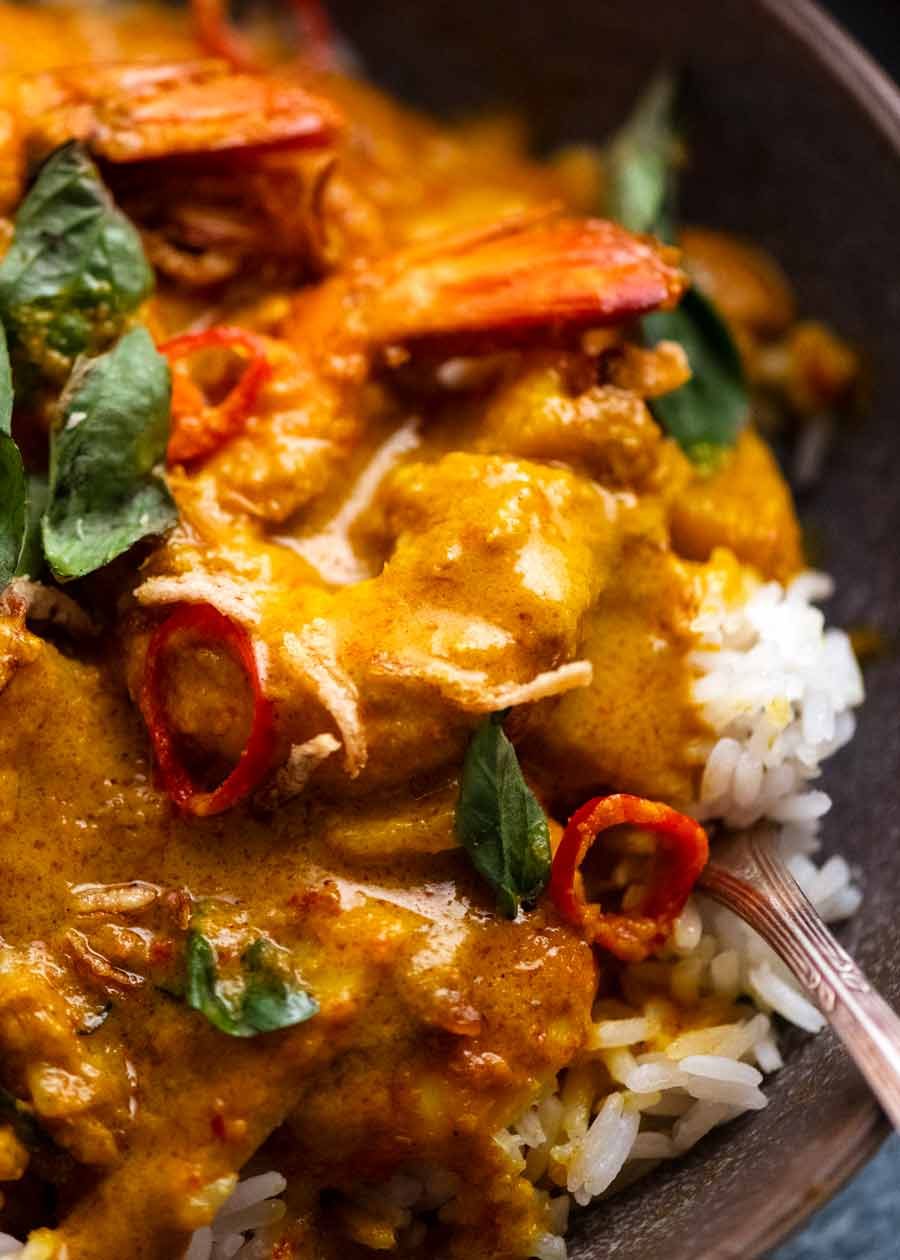
Phew! And with that, I’m finished – you are actually armed with every part you want to know to make this Thai Yellow Curry!
That is actually not a fast ‘n straightforward midweek meal. There’s a good few elements, and to make it as written requires a visit to the Asian grocery retailer. It entails sourcing elements that could be new to you, and making ready elements you haven’t cooked with earlier than.
However is it value it?
Hundred instances over, YES YES YES!
Whereas today, you will get excellent retailer purchased curry paste for Thai Purple Curry, Inexperienced Curry and Massaman Curry, I’m but to seek out an appropriate retailer purchased Yellow Curry Paste, even at Asian grocery shops.
And, on the danger of sounding completely obnoxious, this recipe delivers a curry that’s far superior to most traditional suburban Thai takeout locations that take the jarred curry paste shortcuts.
So for those who’re a Thai Curry fan, I urge you to attempt making this at the very least as soon as. The style is incomparable to canned pastes! – Johnsat x

Ingredients
- 10 dried red chillis (~6cm/2.5" long), chopped into 1cm / 0.5" pieces (Note 1)
- 1 – 4 fresh birds eye chillis , deseeded, roughly (1 for extremely mild, 4 for fairly spicy, Note 2)
- 2 lemongrass stems (Note 3)
- 1 large or 2 small eschalots , roughly chopped (~ 1/2 cup) (Note 4)
- 2 tbsp fresh turmeric , finely grated (about 2cm / 0.8" piece) (Note 5)
- 2 tbsp galangal , finely grated (about 2cm / 0.8" piece) (Note 6)
- 8 cloves garlic , roughly chopped
- 1 1/2 tbsp Thai shrimp paste in bean oil (Note 7)
- 1 tsp ground coriander
- 1 tsp ground cumin
- 1/4 tsp ground cardamom
- 1/2 tsp fenugreek powder (Note 8)
- 1/8 tsp white pepper (sub black)
- 3 tbsp vegetable oil (or canola or peanut oil)
- 1 medium potato , peeled, cut into 2.5cm / 1″ pieces x 1cm/ 0.4″ thick (Note 9)
- 1 small carrot , peeled, sliced into 5mm / 0.2″ slices on the diagonal
- 1 cup chicken stock , low sodium
- 300 ml / 10oz coconut cream (Note 10)
- 4 tsp fish sauce , plus more to taste (Note 11)
- 5 tsp white sugar
- 2 tsp tamarind puree (Note 12)
- 350g / 12oz prawns/shrimp , medium, peeled, tail on optional (700g/1.4lb unpeeled) (Note 13)
- 1/2 cup bamboo shoots , canned, drained, loosely packed (Note 14)
- 16 Thai basil leaves (highly recommended, Note 15)
- 1 Red chilli , finely sliced (optional, use large for not spicy)
- 2 tbsp Crispy fried shallots (optional, store bought, Note 16)
- Jasmine rice
Instructions
- Soak dried chillis: Roughly chop chillies and transfer to bowl, leaving behind seeds. Cover with boiling water and soak for 30 minutes then drain (reserve soaking water).
- Check spiciness: Have a nibble of soaked chilli, should not be that spicy. If it is spicy, only use 1/3 to 1/2 of the amount (Note 1).
- Prepare lemongrass: Remove woody top half and outer layers of lemongrass. Grate with microplane. (See in post or video for preparation demo)
- Make curry paste: Place chillis, lemongrass and all remaining curry paste ingredients in a jar just wide enough to fit a stick blender. Add 3 tablespoons chilli soaking water. Blitz with stick blender until smooth so there's no hard grit – rub between your fingers to check – about 15 seconds on high. (Or use small food processor or Nutribullet, scraping down sides well).
- Cook off curry paste: Heat oil in a medium heavy based skillet over medium heat. (Mine is a 26cm / 10.5" Lodget cast iron) Add curry paste and cook for 3 to 4 minutes until it dries out a bit a smells fragrant.
- Reduce stock: Add chicken stock, stir to dissolve paste, then simmer for 1 minute.
- Add remaining curry sauce ingredients: Reduce heat to medium low. Add tamarind, fish sauce and sugar. Stir until tamarind is dissolved. Then stir in coconut, carrot and potato.
- Simmer: Bring to simmer, then simmer gently for 15 minutes or until potato is almost fully soft. Pierce with knife to check, it might take 20 minutes.
- Prawns and bamboo shoots: Add prawns and bamboo shoots. Stir, then cook for 3 minutes until prawns are just cooked.
- ADJUST sauce: Taste and adjust the curry sauce at this point. Thin sauce with stock or water, add salt, fish sauce or sugar if needed. See Note 17.
- Serve! Transfer curry to serving bowl. Garnish with Thai Basil, fresh chilli and crispy shallots. Serve with jasmine rice.
Notes
1. Dried chilli – Any dried Chinese or Asian chillis around (~6cm/2.5″ long). They are not supposed to be that spicy, they are mainly for flavour and not that much for spiciness (which we get from fresh chilli).
CHECK spiciness! That said, it’s wise to check. Have a nibble once soaked. If you’re concerned it’s too spicy, reduce the amount you use. You can always add more spiciness at the end using fresh chillies for garnish but can’t undo spiciness! (Note: Standard dried chillies at Asian stores in Sydney are not spicy so can use full amount per recipe)
Do not use small Thai chillies – too spicy!
2. Fresh chilli – Use birds eye or Thai chillis. 1 chilli = barely spicy at all. 2 chillies = quite mild. 4 chillis = quite spicy but not blow your head off. See in post for how I deseed and chop.
3. Lemongrass – Fresh is best but lemongrass paste is an acceptable substitute, use 2 tablespoons. Dried won’t be the same, I’m afraid.
4. Eschalots – Also known as French onions, and called “shallots” in the US. They look like baby onions, but have purple-skinned flesh, are finer and sweeter. Not to be confused with what some people in Australia call “shallots” ie the long green onions.
They differ in size, use ~ 1/2 cup once chopped (1 large or 2 small).
5. Turmeric – STAINS so use gloves and avoid porous surfaces once cut (like plastic cutting boards, stone benches)! Scrape or cut off skin using small knife, spoon or vegetable peeler, then grate using a microplane straight into a ceramic bowl.
Turmeric Powder sub – Not the same, but can be done. Use 1.5 tsp
Leftover turmeric – Make this Golden Turmeric Fish!
6. Galangal – Looks like ginger but is more citrusy and harder. Most recipes will tell you just to toss in chunks, but there’s a strong chance you end up with grainy curry. So best to grate.
Find it in some grocery stores in Australia (Harris Farms and some Woolworths sell it). If you can’t find it, use the same amount of ginger + the zest of 1 lime.
7. Thai shrimp paste in bean oil – I use Por Kwan brand, the most popular one sold at Asian grocery stores here in Australia. Note: many traditional recipes use ordinary dried shrimp (belacan) but shrimp paste yields a better result, see in post for why.
If you can’t find Shrimp Paste in oil, Belacan is a substitute that’s nearly as good which, believe it or not, is sold at Woolworths in Australia. Use 1.5 tbsp, roughly chop then toast on low heat in 1 tbsp oil for 3 minutes. Then use in place of shrimp paste.
8. Fenugreek powder – spice that kind of smells like maple syrup. Available at stores that carry a decent range of spices. I found it at Harris Farms (Australia). Also at Asian and Indian grocery stores.
9. Potato – Don’t cut any bigger than specified else it may not cook through. I kept making this mistake!
10. Coconut cream – Thicker and richer than coconut milk. Look for good quality coconut cream that is 100% coconut like Ayam for better coconut flavour (cheap brands are diluted with water). Coconut milk can be substituted. Low fat not recommended – less flavour and too thin!
11. Fish sauce – The salt for this dish which brings it umami and makes it distinctly Thai. Doesn’t make fishy once cooked. If you sub with soy sauce, you will be disappointed by lack of depth of flavour!
12. Tamarind puree – sour paste used in Asian cooking. Find it in the Asian aisle of large grocery stores (Coles, Woolies).
13. Proteins
Prawns – can use frozen, just thaw and drain off excess water well.
Fish – Firm white fish fillets cut into 4cm / 1.3″ pieces. Cook as per prawns.
Chicken – use 300g / 10oz chicken thighs (boneless, skinless), add with potato
14. Bamboo shoots – Find these in cans in the Asian or canned vegetable aisle of supermarkets. Use leftover in stir fries!
15. Thai Basil Leaves – Tastes like regular basil plus a bit of aniseed flavour. Highly recommended to finish this dish off, it’s a traditional herb used for this dish. Best substitute: coriander/ cilantro, followed by Italian basil.
16. Crispy fried shallot pieces – Salty little crunchy shallots, tasty garnish! Found in the Asian section of supermarket but cheaper at Asian stores.
17. Sauce flavour adjustments – Most fresh curries require a final tweak at the end due to differences in flavour/freshness of ingredients used, how quickly it reduces etc. The final taste should lean mostly savoury, with umami and saltiness from the shrimp paste and fish sauce, with the aromatics subtly coming through. It should be pleasantly sweet but not overly so. The spices should come through. There will be very little tang, just a tiny bit (note tamarind looses much of its acidity when cooked so don’t worry if it initially tastes too sour when you added it). It will be moderately spicy.
Thin sauce with water or stock
Thicken with extra coconut cream.
Salt and umami: fish sauce (1 tsp at time), plain salt if if the fish sauce taste is strong enough but it still needs some saltiness
Sweetness: sugar
More spice: use fresh chillies for garnish. Don’t add sriracha or chilli sauce into the curry sauce.
